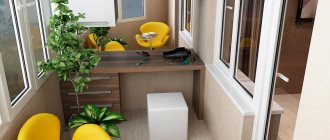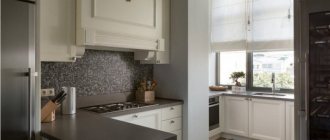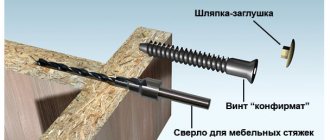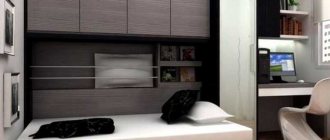Apartments in multi-storey residential buildings in most cases have a great advantage - additional space that can serve different roles. We are talking about loggias or balconies, which are difficult to do without. Recently, these premises are increasingly being turned into fully functional areas - into offices, cinema halls, workshops, greenhouses or mini-gyms. For many owners who have these bonus meters, the concepts of “balcony” and “loggia” are complete synonyms. However, this is a misconception. Despite the same functions, these structures are completely different rooms. Therefore, the topic “loggia and balcony: differences and features of both structures” remains quite relevant even now.
Loggia and balcony: differences prescribed in SNiP
Despite the confusion in concepts, identifying a loggia or balcony is quite simple, even visually.
- The first is a recess - a niche built into the wall. When viewed from the street, it is level with the facade. Usually it is open only on one side, corner loggias - on both. A ceiling is required. Blind walls on the right and left are the main difference between the loggia.
- The second structure is a balcony - a fortified and fenced area that always protrudes from the vertical plane of the wall. The outer side and side walls are replaced by grilles, open or closed with slabs, slate sheets, as well as window frames.
If we talk about the differences quite simply, then the difference between a balcony and a loggia is as follows: the first always protrudes beyond the perimeter of the building, the second is necessarily recessed into the structure, it is an integral part of it.
The difference between a loggia and a balcony: we compare according to different parameters
How to understand the difference between a balcony and a loggia? After all, glazed structures are closer to each other in their functions and even in appearance.
First of all, a balcony and a loggia differ from each other in their practical design - the first structure is hinged, the second is built-in.
- An open balcony often plays the role of a decorative element of a building and is used by residents of the house as a place to relax and spend time in the fresh air.
- The loggia, due to its closedness, even without glazing, allows you not only to “go out and breathe,” but also to place pieces of furniture and storage cabinets.
Dimensions
Another difference between a loggia and a balcony is their area:
- The balcony is limited by the area of the slab protruding from the facade of the building, which usually has standard dimensions. However, they may differ in houses built by private developers.
- The loggia is limited by the size of the rooms to which it is adjacent. The length of such an additional room may include a kitchen and one of the bedrooms, and its width will be standard.
If you need to have more free space, it makes sense to choose an apartment with a loggia.
Load bearing capacity
When comparing the load-bearing capacity of a loggia and a balcony, the first type of structure wins:
- the balcony has restrictions on the total weight of furniture and equipment that can be installed on it, since it itself is an external structure;
- the loggia has no such restrictions - you can install the same items on it as in any room of the apartment.
Possibility of arrangement
To insulate and glaze a balcony, work must be done on its three free sides. This increases the costs when installing double glazed windows because three structures need to be made that require connections. For similar work on the loggia - with only one. But for the owner of a balcony, financial costs may be lower due to the smaller area of the room. Especially if you decide to insulate both the floor and the ceiling.
There is another advantage of a loggia - it can be used to create any room at the owner’s request. This could be an office, a relaxation room or a winter garden. Very often they combine a kitchen with a loggia, then in addition to the total area they get a heated dining room. Transferring sections of central heating batteries to the balcony is prohibited. Therefore, making it a warm room for the winter is more problematic, since the additional room will have to be heated with electrical appliances.
And yet, what is better – a balcony or a loggia? From their comparison, we can conclude that an apartment with a balcony area is preferable if we consider this design from an aesthetic point of view. From the standpoint of practicality, the wealth of possibilities of the loggia looks more attractive. The choice is yours!
History of both designs
The stories of their origin and purpose were also different, and the names of foreign architectural elements “migrated” from different languages.
- Balcony - the French word is balkon. It, in turn, comes from the old German name for a beam - balko. The first designs were not full-fledged balconies: they looked like a simple ledge located near the window. After some time, they acquired fences to protect people walking from falling.
- Loggia is an Italian word - loggia. It translates as “an open gallery located along the wall of a building, formed by a parapet, colonnade or arch.” This concept “moved” into modern Italian from Latin.
These designs had very little in common at the beginning of their "architectural careers". But over time, they have become synonymous for many Russians, but they still have more differences than it seems at first glance.
What is a balcony
First, let's take a moment to understand the concept of “balcony” and understand the history of its origin and design features. Having learned what a balcony looks like, you can understand the differences with a loggia.
The history of balconies
In French there is a word, balkon, which comes from an old German word for beam. And yes, in fact, a balcony used to be an ordinary ledge near a window. Gradually, such a ledge was overgrown with a fence, giving a person the opportunity to “take a walk” without leaving the apartment or house.
You should not carry out heavy construction work on balconies, since the base slab is not intended for such loads, any developer and SNiP rules will tell you this.
Features of the building structure
The balcony extension looks like a slab protruding from the wall of the house, fenced on three sides with railings.
The railings are also attached to the wall, but the entire load falls on the protruding slab of the balcony.
Balcony structures can be:
- cantilever beam: consoles hold the base, but such structures are a thing of the distant past;
- reinforced concrete base: a slab of this kind is located in brick buildings;
- cantilever base: there is no support here;
- external supports: if the balcony is large and on the second floor, then this modification is very successful from the point of view of the exterior of the house.
Balcony types:
- rectangular;
- semicircular;
- triangular;
- elongated;
- trapezoidal.
Architects realize their vision in different ways, and builders bring these ideas to life. This is how the historical appearance of the building is born, but today loggias are still most often built.
The difference in the shapes of balconies and loggias
In this case, the differences are significant, since one of the compared “representatives” is in a more advantageous position.
Loggias are outsiders
If we consider loggias, then the recessed structure cannot boast of a wide variety of shapes. The load-bearing walls enclosing the room are “to blame” for this. The built-in structure only repeats the structural features included in the building design.
Therefore, there are only two types of loggias, which are very common in our country: traditional structures, limited on 3 sides, and corner structures, which have fences on only 2 of them. Yes, there is still some variety: for example, rounded architectural elements, but they also belong to the traditional look.
Balconies are winners
Their sizes, types of structures and shapes may differ, but they have one thing in common: this base is a reinforced concrete slab that protrudes significantly beyond the walls of the building. It is fixed only on one side, so it is not allowed to overload these structures.
The shapes of balconies are different; these “extensions” are:
- rectangular - traditional;
- triangular;
- trapezoidal;
- rounded;
- semicircular;
- elongated.
Their forms depend on the wishes of the project customer and on the ability of the architect to translate ideas into reality. Therefore, listing absolutely all types of designs is impossible: the wild human imagination knows no limits. Typical structures in most cases have a convenient rectangular shape, sometimes there are rounded structures.
Now loggia and balcony have begun to “specialize” in different areas: the differences are in their purpose. The former are more often found in residential multi-storey buildings, the latter, on the contrary, are done on non-residential, administrative, and industrial buildings.
Balcony - definition
Initially, you need to decide which areas can be called a loggia and a balcony. This can help when choosing an apartment to buy.
A balcony (translated from several European languages as a beam) is a platform with enclosing railings that protrudes from the outside of the building and has a passage into the interior. In fact, this is a hanging slab, permanently fixed at one end in the outer wall of the building. The other three sides only have fencing.
Loggia and balcony: differences in size
The area of the premises is another parameter that can vary greatly between both buildings. It is largely influenced by the structural features of the building, because the dimensions of both loggias and balconies depend on the dimensions of reinforced concrete slabs that are used in the construction of a particular facility.
The area of the balconies of new houses is 100x320 cm, but these figures vary depending on the developed project. Floor slabs used in the construction of buildings with “born Italians” are standard - 120x580 cm. But even in this case, only the slabs determine the area, and their size can also be different. Therefore, it is better to say only one thing about the difference between rooms - built-in structures are always larger than external rooms. There are also no strict standards regarding the height of structures: this value depends on the height of the ceilings in the apartments of the building.
The difference in area is easily explained. A large balcony located outside the perimeter of the building is an extremely difficult task, almost impossible due to the design features. Loggias located on floor slabs that rest comfortably on the walls are able to withstand almost any household load.
For balconies located on a single load-bearing slab, glazing, insulation and finishing material become a significant weight. If you add even small furniture to this list, then the slab, which is attached to the building on only one side, becomes a source of danger. And both for residents and for their neighbors.
What is a loggia?
A loggia can be defined as a space built into the area of a house, enclosed on several sides by walls. In this case, the determining factor will be that the loggia is not an external space; it will necessarily be located within the walls of the building.
Loggias can be divided into several types:
- Built-in
Such a loggia is a room closed on three sides by walls. The floor slab rests on the load-bearing walls of the building;
- Remote
The slab of this type of loggia rests on the cantilever beams of additional walls, built perpendicular to one of the walls of the building.
- Corner
In this case, the loggia is fenced with walls on only two sides, the other two remain open.
Loggias, like balconies, can be glazed or open, but the main condition for them is the presence of a low enclosing wall made of concrete, iron or wrought iron fencing, or glass.
Convenience, functionality
In these “nominations” the undisputed leader is the loggia. First of all, this concerns the arrangement of premises when turning them into a fully functional room. A lot of funds will be required to insulate the external balcony, since all three walls need glazing and thermal insulation. In the loggia, work is carried out only on two or one side. However, a small room also has an advantage: less materials will be needed for repairs.
The loggia, which is part of the apartment, allows you to make it an extension of the room and install any heating devices in it. It is simply impossible to insulate a balcony using many of them. The installation of a “warm floor” system is not always permitted due to the critical (or close to it) condition of the balcony slab. If we talk about modern building codes, then both structures must withstand exactly the same load - 200 kg per 1 m2.
Construction of balconies on the first floor
As a rule, residents of the first floors are deprived of such additional convenience as a loggia. Therefore, we will consider the process of manufacturing structures suitable for extensions on the lower floors.
Extension of a suspended balcony
The considered balcony project on the first floor involves a suspended mounting structure. What a suspended balcony looks like is shown in the photo below.
This is how you can build a suspended balcony on the first floor
The structure we are considering consists of a metal frame attached to the wall of the building.
Note: an extension to the building of a suspended balcony is possible not only on the 1st floor, but also on the 2nd floor (with high-quality welding of the structure and reliable fastening).
We begin construction by making a frame from metal corners. Corners of 60x60 mm are used for the base, and 45x45 mm for the parapet. The base is an isosceles right triangle.
Construction of a suspended structure frame
After completing the welding work, we fasten the base to the wall with anchor bolts. A metal frame is welded onto the upper shelves of the base - a support for the balcony floor. Next you need to attach the parapet.
We dismantle the window block and select an opening for the door block; it is necessary to install pre-prepared blocks in them (how to make an opening in the wall can be found on the Internet).
The construction of the base of the suspended structure is completed. The following works remain:
- Flooring - we lay wooden logs that serve as the basis for the floor covering, for example, an OSB board. We insulate the floors and lay out decorative coverings.
We weld a metal sheet under the base, which serves as protection against arson and penetration.
- Attaching decorative exterior cladding. You can use a professional sheet.
- Glazing of the constructed balcony, its insulation. This work is carried out as on ordinary balconies.
In addition to the standard form, a balcony can be built with an extension - an extension of the balcony room.
Also, during construction, one should not forget about the aesthetic side. Your building will look more complete when you decorate its supporting frame.
Suspended (or curtained) balcony on the ground floor
Loggia and balcony: differences in price
The cost of housing with these premises is slightly different. When buying or selling an apartment, its footage is calculated depending on what kind of building is located in it. A reduction factor is used for calculations. For living space with a loggia it is 0.5, and for apartments with balconies, which are equivalent to terraces, it is 0.3. This difference is fundamental for many.
How is the cost calculated? The area of the balcony or loggia is multiplied by this coefficient (0.3 or 0.5, respectively). The resulting value is added to the area of other rooms. The result is multiplied by the price of 1 square meter, which is how the price of a specific apartment is calculated.
Peculiarities
Taking into account the differences between the two types described above, it becomes clear why the loggia is identical to the room even when not glazed. When selling or buying real estate you need to take this into account. There is a difference in odds here.
The size of the total living area is the sum of the room inside the house and the balcony space. In the case of a balcony, the coefficient is 0.3, and in the case of a loggia, 0.5.
Thus, the cost of an apartment with a loggia (with the same square footage) will be higher. Therefore, it is important to understand the difference between these two designs in order to make the correct calculations.
To summarize
Loggia and balcony are rooms that perform the same function. It is because of this similarity that confusion in concepts most often arises. But their differences are significant.
- Design. The balcony is a remote element; the loggia is always recessed into the building.
- Closed sides. The first structure has only one - the one that also serves as the wall of the building. The second one may have 2 or 3.
- Square. The leader here is the built-in room, the length of which may not be limited by the width of one room. The size of the balcony structure is determined by the slab located outside the walls of the building, so its area a priori cannot be large.
- Strength. The support for the loggia is one of the load-bearing structures of the building, so it can withstand considerable weight. An external balcony slab, attached to the building on one side, has significant restrictions regarding loads.
- Functionality. The loggia can be relatively easily transformed into any comfortable area. To make a comfortable and warm room out of a removed structure, the owners have to try very hard and also invest more money.
Now new designs have appeared, which are called remote and loggia balconies. These “curiosities” are both recessed and/or protrude from the building’s façade. Many owners call such original structures “balkodzhi” or “logicons”.
Designs of balconies, loggias, bay windows
Having decided to re-equip or repair a balcony or loggia in your apartment, you should understand that any manipulations associated with the reconstruction and redevelopment of these premises must necessarily comply with regulatory requirements. The main document regulating this type of activity is SNiP. Balconies and loggias, in accordance with this set of rules, are designed and built taking into account to prevent their damage and destruction during operation.
According to the requirements of SNiP, a loggia or balcony of an open or closed type should not exert additional pressure on the load-bearing and enclosing structures of the building in which they are located. When installing them, it is also important to take into account fire safety requirements and established sanitary standards.
In addition, this regulatory act explains in which cases the construction of these premises is inappropriate due to unfavorable operating conditions. GOST loggias and balconies are taken into account in the documentation SNiP 31-01-2003 “Residential multi-apartment buildings”, which contains a detailed list of conditions that must be met when carrying out redevelopment and re-equipment of these premises, as well as general requirements for the construction of residential buildings of various types.
SNiP 31-01-2003 “Residential multi-apartment buildings” (406 KB, pdf)
One of the important stages associated with the arrangement of balconies and loggias of various types is the construction of a new balcony railing, which ensures reliable and durable fixation of the main structure. When performing work of this type, you should use GOST for balcony fencing, number 25772-83, which contains instructions for the design and installation of various types of fencing.
In accordance with established standards, only screen-type structures can be used for fencing balconies and loggias. Moreover, these elements must withstand the level of loads provided for in SNiP 2.01.07. GOST for balcony railings indicates that the total height of the balcony railing should be:
· in buildings up to 30 m high - 1000 mm;
· above 30 m – 1100 mm.
The height of the railing of the enclosing element must be at least 900 mm, and their load-bearing capacity must be an order of magnitude higher than a conventional staircase railing. One of the important conditions for their design and construction is the absence of sharp protrusions and raw edges.
Also, increased demands are placed on the safety of constructed balcony railings. For this purpose, the use of horizontal type elements is prohibited.
GOST 25772-83 Steel fencing for stairs, balconies and roofs. General technical conditions (449 KB, pdf)
The most common technique used to ensure a sufficient level of noise and heat insulation on balconies and loggias of various types is their glazing. The basic requirements for devices for window and balcony door units are described in GOST 30777-2012.
This set of rules contains instructions for the manufacture and installation of rotary, tilting and tilt-and-turn devices, as well as other elements included in various types of window and door balcony units.
In particular, it contains technical requirements for the design, dimensions and maximum deviations, reliability and load resistance and ergonomic characteristics of structures made of various materials used for glazing balconies.
In addition, this document also contains applications with diagrams and examples of the design of rotary, tilting and tilt-and-turn mechanisms with individual components and elements.
GOST 30777-2012 Rotary, tilting and tilt-and-turn devices for window and balcony door units. Technical specifications (2.2 MB, pdf)
The rules for glazing balconies according to GOST are described in the document “Window installation seams with vapor-permeable self-expanding tapes. Technical conditions" (GOST R 52749-2007). It specifies the requirements for the installation of assembly joints during construction work when installing window and door units.
GOST R 52749-2007 Window installation joints with vapor-permeable self-expanding tapes. Specifications (1.09 MB, pdf)
The basis of any balcony structure is a reinforced concrete slab onto which the remaining elements of the structural system of this building element are fixed. For this purpose, flat multi-hollow, flat solid and ribbed loggia slabs are used. GOST 25697-83 “Reinforced concrete slabs for balconies and loggias. General technical conditions" divides them into varieties of cantilever and beam type, differing in the method of location in relation to the supporting structure and the characteristics of the operation of the slab.
In this case, the choice of the shape and size of the slab in each specific case is made in accordance with the construction conditions, structural features of buildings and architectural and artistic tasks.
GOST contains technical requirements for the manufacture and installation of these elements, indicating the maximum permissible deviations, as well as standards for the quality and appearance of products. It also contains background information related to the operating features of balcony slabs and the grades of concrete used for their manufacture.
GOST 25697-83 Reinforced concrete slabs for balconies and loggias. General technical conditions (163 KB, pdf)
Designs of balconies, loggias, bay windows
The spaces formed by protruding horizontal structures of buildings are classified as summer rooms. It is advisable to place open summer rooms (balconies) in a temperate climate zone next to the common room and kitchen, and in the southern regions also next to the bedroom.
The depth of summer rooms should be at least 90 cm for middle climatic regions and at least 120-180 cm for southern ones, since sleeping places and places for eating are often placed there in the summer.
Balconies, bay windows, loggias significantly increase the comfort of apartments due to communication with the external environment and at the same time they enrich the plasticity of the facades. The rationality of their use depends on the climatic characteristics of the construction area. In hot climates, balconies and loggias shade the interior from excess insolation.
Bay windows, which increase illumination and insolation of the interior volume of the room, are well used in northern regions.
| Types of summer premises: 1 - open balcony (a - cantilever, b - on poles); — a balcony with windproof screens on one (c) or two (d) sides; 3 - corner balcony; 4 - loggia (d - recessed, e - protruding); 5 - loggia - balcony (w - semi-recessed, 1 - adjacent to the facade plane); 6 - terrace | |
The construction of open spaces - balconies and loggias in residential and public buildings of mass construction is carried out from standard factory-made structural elements.
When constructing buildings on steep slopes or with a façade that slopes deeper into the interior, open terraces
, located above the operated volumes. The floors of such terraces serve as exploitable roofs for the volumes being covered, which requires careful attention to waterproofing issues.
The design features of balconies, loggias, and bay windows are multivariate and depend on the construction and structural systems of the building.
| Balcony | |
| Loggia | |
| Bay window | |
| Open spaces and bay windows in civil buildings: A – balconies and loggias; B – bay windows; a – open balcony; b – balcony with a windproof screen; c – built-in loggia; d – external loggia; d – built-in loggia-balcony; e – remote loggia-balcony; g – asymmetrical triangular bay window; h – the same, symmetrical; and – the same, rectangular; 1 – balcony slab; 2 – balcony (loggia) fencing; 3 – wind screen |
Balconies
- open cantilever platforms with a projection of 90-120 cm from the wall plane, with fences up to 1.0 m high on three sides. The shape of balconies can be varied - rectangular, trapezoidal, triangular, curved, sawtooth, etc.
Balconies perform two main functions in an apartment: they serve for relaxation and as a place to carry out various household chores (planting flowers, drying clothes, airing things, storing food).
In design practice, balconies are open with windproof walls, and loggias are built-in, remote, as well as remote and built-in loggias-balconies.
According to their static scheme, balcony slabs can work:
· as a cantilever slab that transmits bending moment and vertical support reaction to the wall structure and the building’s floor;
· as a beam slab, which has alternative solutions for supporting the sides: - on cantilever beams, suspension to the internal transverse walls of the building or support on outriggers.
| Schemes for transferring bending moment and vertical forces from the balcony slab to the structure: a - external load-bearing wall; b - lightweight concrete floor panel (and external wall); c — consoles; g - brackets; 1 - balcony slab; 2 - outer wall; 3 - overlap; 4 - sealant; 5 - insulation; 6 — rain ridge; 7 — console; 8 — bracket | |
The connection between the balcony slab and the outer wall and ceiling must satisfy not only the strength requirements, but also provide thermal insulation. Therefore, when making balcony slabs from heavy concrete, thermal insulation is laid in the joint between the balcony slab and the floor slab. The balcony slab can be an external cantilever part of the floor panel, molded from lightweight concrete.
| Balcony structures: a - made of reinforced concrete slabs; b - on reinforced concrete consoles; 1 - balcony slab; 2 - floor slab; 3 - insulation; 4—cement screed; 5—waterproofing carpet; b—floor; 7—drain, 8—beam | |
Balcony fencing is usually made in the form of a metal lattice. The most critical areas are the places where fence posts are embedded in the slab and handrails in the wall.
Steel parts of balconies must be protected from moisture. To protect the beams from corrosion, they are concreted. Cement-sand or gypsum parts were used as architectural decorations for balconies. Fastening parts are the most susceptible to destruction, so special attention is paid to their protection from atmospheric influences.
The balcony slab has a smooth lower plane or ribs protruding along the contour, but in all cases, along the bottom of the outer edges of the slab, a teardrop must be installed that prevents the outer surface of the building wall from getting wet. The upper plane of the balcony slab is made with a slope of 1-2% from the front plane of the wall.
The waterproofing carpet is laid on top of the slab with its top sealed along the wall of the building. A floor of ceramic tiles is laid over a layer of waterproofing on a cement or asphalt screed, located 50-70 mm below the floor of the room to which the balcony adjoins and 100-120 mm below the level of the door threshold.
| Connection of a balcony slab with a ceiling made of frequently ribbed slabs with lattice reinforcement - located perpendicular to the balcony overhang : a) vertical section through the structural rib, b) placement of the balcony slab reinforcement; 1 - flooring made of frequently ribbed slabs; 2 - crown of the ceiling; 3 - floor blocks; 4 - jumper made of U-shaped blocks; 5 - finishing layers of the balcony; 6 – teardropper; 7 - main reinforcement of the balcony slab; 8 - floor layers of slabs with lattice reinforcement; 9 — thermal insulation of the reinforced concrete crown; 10 - hollow blocks; 11 - floor beam; 12 — axis of the floor beam; 13 - tin roofing products; 14 — thermal insulation of the balcony slab | |
Special balcony slabs are used to construct balconies. Such slabs in large-block buildings are secured by pinching the slab between the transfer, wall and sill blocks and welding steel anchors to the embedded parts of the lintel block and balcony slab.
| Balcony slab connection from precast heavy concrete slabs : a) vertical section through the structural rib, b) placement of the balcony slab reinforcement; 1 - floor made of prefabricated slabs; 2 - crown of the ceiling; 3 - blocks; 4 - jumper made of U-shaped reinforcement blocks in the hollow channels of the slabs; 5 - finishing layers of the balcony; 6 - teardropper; 7 - upper reinforcement of the balcony slab; 8 - floor layers of heavy concrete; 9 — thermal insulation of the reinforced concrete crown; 10 — holes for concreting; 11 - tin roofing products; 12 — thermal insulation of the balcony slab | |
The upper reinforcement of the balcony is concreted in the channels of the prefabricated slab in increments of one channel.
In large-panel buildings, depending on the designs of external walls (load-bearing, non-load-bearing) and ceilings, various schemes for constructing balconies are used.
| Balconies of large-element buildings: A – diagrams of force transmission from balcony slabs in panel buildings; a – on load-bearing external walls; b, c – on the floors; d – on the attached racks; B – details for fastening balcony slabs in panel walls (type “c”); B - the same, in large-block walls; 1 – interior wall panel; 2 – outer wall panel; 3 – balcony slab; 4 – insulating liner; 5 – steel connections; 6 – floor slab; 7 – reinforcement outlets; 8 – cement mortar; 9 – embedding concrete; 10 – sealing; 11 – wall blocks | |
The covering of loggias-balconies is made of balcony slabs, floor panels, as well as special slabs with a reinforced façade rib.
The ceilings of built-in loggias-balconies are supported on the external side walls of the loggias, and external loggias and loggias-balconies are supported on special attached or curtain walls of concrete - “cheeks”. Fencing of balconies and loggias
consists of a metal grid and blind or lattice fences attached to it - screens.
Fencing for balconies and loggias is made of metal gratings reinforced in the concrete slab of the loggia (balcony) floor. The fence can be solid, with the lattice covered with decorative sheets of fiberglass, corrugated metal, etc., as well as with a brick wall a quarter brick thick.
Floors on balconies and loggias are made of ceramic tiles, cement-iron surfaces, and asphalt.
Loggias
They can be built into the volume of the building or protrude beyond the facade plane - external, but in both cases they have a blank side fence. When loggias are built into the volume of the building, the installation of adjacent insulated side (end) walls is required.
In order to eliminate cold bridges, heat-insulating gaskets are installed in the ceilings of loggias installed on the outer wall.
The design of external loggias is carried out using additional load-bearing or curtain side walls perpendicular to the facade, protruding consoles of frame columns or cantilever beams clamped in the transverse internal walls.
| Loggias in large-element houses: A – schemes of remote loggias; a – with load-bearing walls of loggias; b – with curtain walls of loggias; c – on the consoles of internal load-bearing walls; d – on the consoles of the frame columns; B – structural elements of loggias in large-block buildings; B – the same in large-panel buildings; 1 – reinforced concrete loggia slab; 2 – floor panel; 3 – reinforced concrete screen; 4 – wall of the loggia; 5 – drain pipe; 6 – loggia wall clamp; 7 – large jumper block; 8 – base decorative panel; 9 – large panel of the outer wall | |
Load-bearing side walls of loggias are used only for mid-rise buildings. At the same time, to ensure the joint settlement of the loggias and the walls of the building, the side cheek-walls of the loggias rest on sections of the foundations of the transverse internal walls, placed beyond the plane of the facade.
Designs for sliding glazing of loggias have been developed, which best meet the requirements of comfort in the middle and northern climatic zones of Russia. When glazing balconies or loggias, a significant drawback arises, expressed in a decrease in the luminous flux by an average of 15-20%, since the wide vertical and horizontal imposts of the fence frames impede the passage of the luminous flux.
According to its structural type, a loggia is a room open on one or more sides, included in the overall volume of the building and fenced from the outside with a parapet. A loggia can be a separate structure or a type of balcony recessed into the building. Loggias are based in old buildings mostly on slabs or floor beams, in modern construction - on protruding pilasters. Water drains from the loggias through drainage holes. The slope of the loggia floor must be at least 5%. Loggia floors are usually waterproofed with rolled roofing carpet or other insulating material.
| Loggias and terraces: vertical section - a) loggias, b) terraces; 1 — fencing blocks; 2 - floor slabs; 3 - layer forming the slope; 4 - vapor barrier; 5 — crown insulation element; 6 - anti-damp insulation; 7 - cement covering layer; 8 - finishing layer; 9 - layer forming the floor and underground layer; 10 - concrete tiles | |
The frameless glazing design eliminates this drawback. It is a frame assembled from four aluminum profiles, which repeats the dimensions of the balcony or loggia opening with an accuracy of 2 mm. The upper horizontal aluminum profile is load-bearing, with shelves on which a pair of double roller supports roll, carrying sheets of tempered glass.
The lower profile is a guide. Vertical profiles with brush seals ensure a tight fit of the glass to the walls of the loggia (balcony). All frame elements are attached to the walls, ceiling and fencing of the loggia or balcony. The finished glazing is a solid wall of 6 mm thick tempered glass without frames or vertical posts. For ventilation, a mechanism is provided for fixing open sashes.
| Bay windows and types of loggias: a – “hanging” bay window, combined with a balcony on the next floor; b – bay window on three floors; c – general view of the loggia; d – plan of the sinking loggia; d – the same, partially sinking; e - the same, mounted; 1 – outer wall of the building; 2 – walls of loggias; 3 - fence | |
Bay window
— the volume of the building’s internal space placed beyond the façade plane ensures an increase in insolation of the usable area of the room and aesthetically enriches the interior. In plan, bay windows can have different configurations - rectangular, triangular, trapezoidal, semicircular, etc.
The bay window is an active means of the building’s composition, emphasizing the division and plasticity of the facade plane. It can be a separate compositional accent, it can be rhythmically repeated along the vertical plane of the building, or, alternating with flat sections of the wall and sinking loggias, it can create an active light-and-shadow plasticity of the facade.
The walls of bay windows can be either load-bearing or non-load-bearing, and can be made in the form of a volumetric element hung on the building structure.
For load-bearing walls, bay windows are installed on foundation structures. With a suspended system, the bay window volume may not reach the foundations and may be interrupted anywhere vertically.
The non-load-bearing lightweight external walls of the bay window are supported by various types of consoles of internal load-bearing structures - consoles of frame columns, beams clamped in the internal walls, consoles of floor slabs.
In hinged bay windows, it is necessary to comply with the thermal protection conditions of its lower and upper ceilings, which are external enclosing structures.
An industrial volumetric bay window element has been developed, intended for use both in new construction and in major repairs and reconstruction of residential buildings.
The volumetric bay window consists of an external reinforced concrete three-layer wall and one upper load-bearing ceiling, is manufactured using bench technology and delivered to the construction site with the maximum degree of factory readiness.
Bay windows are designed with load-bearing, self-supporting and non-load-bearing external walls. Load-bearing and self-supporting walls of bay windows are installed on an independent foundation and designed similarly to the structures of external walls. The non-load-bearing external walls of the bay windows rest on special cantilever floor slabs that repeat the shape of the bay window plan.
| Bay window design: a – section along the bay window; b – plan of bay window beams; 1 – lightweight outer wall; 2 – overlap; 3 – cement floor; 4 – slag; 5 – parquet; 6 – subfloor; 7 – backfill; 8 – reinforced concrete slab; 9 - plaster | |
Brick vaults, which are the load-bearing filling between metal beams, were usually laid out on lime mortar, which, when moistened, quickly collapses over time.
A bay window is a part of a room enclosed by external walls, located behind the outer plane of the facade wall (closed balcony). The bay window increases the usable area of the room and somewhat improves insolation. In addition, it serves as a compositional means for the vertical division of the facade.
The bay window consists of a supporting and enclosing structure. The elements of the supporting structure are two or more single-span beams with consoles embedded in the outer or inner walls.
The elements of the enclosing structure of the bay window (walls, ceilings, floor) must have the necessary thermal resistance and low density, so the material for them is usually hollow ceramics, multi-hole or slotted brick, foam concrete or reinforced concrete panels with an internal insulating layer. The bay window cover often serves as a balcony for the floor above—a flat roof.
Which room is better?
Anyone who wants a definite answer will be disappointed because he will not receive it. Both designs have advantages and weaknesses. Some people prefer balconies for their panoramic views and the feeling of open space. Recessed structures, often tightly closed on the sides, on the contrary, cannot boast of this space and a lot of light.
The room adjacent to the removed structure is illuminated as much as possible, but the owners have to pay for such insecurity in cold winters. For those who do not assign big tasks to balconies and use them in a traditional way, these premises are ideal.
More spacious loggias make it possible to significantly increase the useful footage of the apartment, obtaining a full-fledged room. There is less light, but the other side of the coin is heat savings. To preserve it on balconies, their owners have to make every effort.
The main question was not about the favorite in this duet of unheated rooms, since the topic of “research” was a loggia and a balcony: differences in designs. The answer will give you a chance to no longer get confused with names, because built-in and remote structures can be easily distinguished even visually.
The topic will end with the following video:
What's better
Of course, it is impossible to give a definite answer to the question of which is better: a balcony or a loggia. Both structures have a lot of advantages and disadvantages. Some people like the feeling of open space that a balcony gives. Thanks to the panoramic view, you can observe everything that is happening around. The loggia does not give such an effect, because it is closed on three out of four possible sides.
The room adjacent to the balcony is much lighter than the one adjacent to the loggia, thanks to the natural light flux, but in winter it is cooler. A balcony is an ideal option for those who love compact and neat structures to provide the most necessary functions - drying clothes, storing useful little things, having an open source of fresh air in their apartment.
The balcony is also ideal for those people who would prefer a beautiful, stylish element of façade decor to a functionally significant room. In this regard, the loggia is significantly inferior to the balcony, being, in essence, a continuation of the wall and not carrying any aesthetic value. The variety of balcony grilles and fences, shapes and designs is amazing. Especially when it comes to balconies decorated using artistic forging.
The façade, decorated with round and curved forged grilles with decorative metal elements, is more reminiscent of a royal palace than a residential building. The French balcony carries absolutely no functional load, but is an excellent example of decor.
Those who want to expand their home by adding another full room, of course, prefer spacious loggias. They are much safer from a design point of view, have larger dimensions and provide more capabilities. They provide less light, but they freeze much less in winter, and there are practically no drafts from them, which cannot be said about balconies. Although this largely depends on the quality of the repairs performed.
So, both the balcony and the loggia have their pros and cons. However, if desired, with a little imagination, you can turn any of them into a full-fledged, comfortable and cozy room for household and household needs.
What is the difference between a balcony and a loggia in an apartment in terms of design parameters?
Let's take a closer look at all the nuances and differences of the mentioned architectural structures.
According to the method of adjoining the main room
To understand the difference between a balcony structure and a Florentine architectural solution, it is enough to look at how they are adjacent to the facade of the building. The balcony will always protrude from the wall of the house, and the loggia is in harmonious relationship with the facade, being its built-in part.
By the number of sides open to view and size
If you look from the geometry side, the balcony is open to three sides of the street and has a standard size of 3275x800 mm. Basically, the width of the balcony is standard.
Rectangular base
Triangular shape as part of modern architectural design
The photo shows the difference between a loggia and a balcony
The loggia is open to the street on only one side, rarely on both sides (in a corner location). The base is always slabs, most often with a size of 1200x5800 mm.
Nuance! Most often, there is one slab for two loggias.
According to possible loads on the structure and methods of arrangement
The safety of the loggia will be higher in any case, since it is not a suspended structure, but part of the building, and the load is distributed evenly on three sides. Due to the way it is connected to the facade, the balcony has restrictions on load and arrangement possibilities.
Types of balconies
The design and construction of such a structure can vary quite a lot. It all depends on the type, cladding and material of the house itself. It is extremely important that the style of the balcony does not stand out against the background of a private building. The most common options are:
- Concrete-based balconies.
- Wooden structures.
- Forged.
- French balcony.
Concrete balconies
Balcony with concrete floor Source pskb.ru
See also: Contacts of construction companies that offer house design services.
A fairly common solution is a concrete floor structure. It has a number of nuances:
- The supporting structures of one side must be attached to the wall of the building. Their connection is carried out using electric welding with pre-installed anchors. The strength of the entire structure will depend on the thickness of the surfaces. If the walls of the building, which must distribute the load, are not reliable enough, you will need to build spare supports.
- The depth and reach of the structure should not be more than 1 m.
- In brick-based houses, the slabs are built into the load-bearing surface along their entire length. They are connected to the lintel reinforcement by welding.
- The top level of the main support slab should therefore be approximately 100mm below the level of the floor surface.
- The floor of the balcony should have a slope of 2% from the main building.
- The concrete slab must be treated with waterproofing materials. To do this, a special protective material is installed on it, onto which a solution based on sand and cement will be poured.
- The parapet parts of the extension must be at least 1 m. For this, metal gratings based on handrails and racks can be used. The rack is installed using electric welding to the embedded materials of the slab, and the edges of the product are immersed in the load-bearing surface of the house.
- The threshold for the doorway should be installed 100 mm above the floor surface.
Wooden buildings
Wooden balcony Source balconymaster.ru
An open wooden balcony on the second floor in a private house is also quite popular. The nuances of its arrangement include:
- The load-bearing products of such structures are beams. For their production, wooden panels with a section of 10 by 20 cm are used.
- With a depth of at least 25 cm, the board is attached to the load-bearing surface and treated with solutions to protect it from moisture or lined with similar materials. The interval between beams should be 80 cm.
- The beams are fastened using angles or strips of steel.
- Wooden posts 4 by 10 cm are attached to the beams.
- After that, longitudinal ones with a size of 5 by 10 cm are also attached above the console panels. The interval between them should be 30-40 cm.
- To ensure increased rigidity, grooves approximately 3 cm deep are installed at the connection point between the longitudinal and console panels.
- The floor is also laid using 4 cm thick boards.
- The partition must be erected from panels with a section of 3 by 13 cm. They are attached to the racks using screws or nails.
- The wooden handrail should have a cross-section of 4 by 9 cm. It is attached with nails to the racks and installed in the supporting structure.
- All components of a balcony in a wooden house must be treated with a hydrophobic solution or oil, this will provide them with protection from rotting and deformation. Fences and handrails must be additionally lined with a frost-resistant compound in several layers.
Forged structures
Forged balconies Source art-kov.ru
This type of balcony has an attractive appearance, especially in a brick house. Its construction has the following nuances:
- The forged extension should not be larger than the size of the slab and the opening; this will eliminate the need to cut the lattice. Minor reductions would be welcome.
- When installing such a structure, it is necessary to take into account the condition of the slab, since metal materials will exert a large load. The surface of the base must be smooth without significant unevenness or damage.
- To restore the quality of the slab, you will need to process the embedded parts, to which the decorative grille will be attached during installation.
- To restore the reinforcement of the coating, the first layer of finishing is removed from it down to the base.
- If the slab is broken or deformed at the edges, the frame must be welded in such a way that it is possible to pour cement mortar without changing its shape. The frame is welded using metal.
- Iron mortgages are attached to the attached sections of the frame. They will help with the installation of the partition.
- After all the elements are welded, the formwork is installed and the slab is poured.
- The grating should be installed only after the cement mixture has completely hardened. The same applies to other construction procedures. The time for complete hardening will be approximately a month.
- If the slab has some damage, you should not use a composition based on cement and sand to restore it, as it will fall off quite quickly.
- To repair minor cracks, tile adhesive is added to the composition in an amount equal to cement. If the applied layer is no more than 20 mm, you can use only glue.











